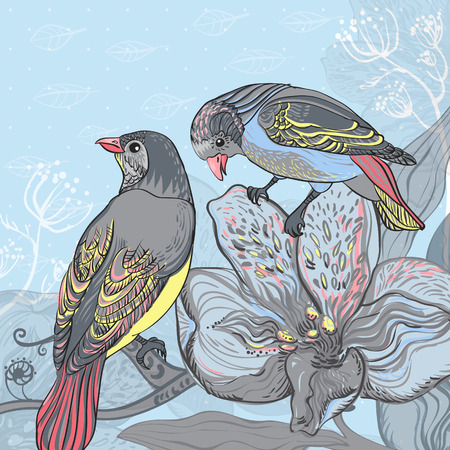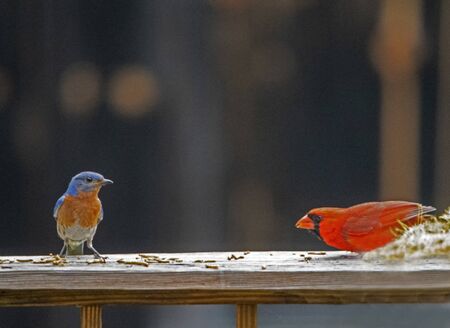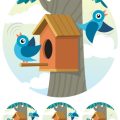Introduction to Garden Birds in the UK
There’s nothing quite like stepping out into a British garden and being greeted by the cheerful flutter of wings and melodic birdsong. Whether you’re sipping your morning cuppa or enjoying an afternoon potter with your furry companion, garden birds are a quintessential part of UK outdoor life. From bustling cities to tranquil countryside villages, these feathered visitors bring a unique charm and natural vibrancy to our green spaces. But who are these regular guests gracing our bird tables and hedgerows? Here’s a handy overview of some common bird species you’re likely to spot in British gardens, each contributing their own dash of colour and character:
| Bird Species | Distinctive Features | Typical Behaviour |
|---|---|---|
| Robin | Red breast, round body, friendly presence | Confident; often seen hopping close to humans and pets |
| Blue Tit | Blue crown, yellow belly, agile movements | Energetic; acrobatically flits between feeders and branches |
| Blackbird | Males: black with yellow beak; Females: brown | Lively singers; forages on lawns for worms |
| Sparrow | Brown and grey plumage, social nature | Chirpy; often found in noisy groups around bushes |
| Goldfinch | Bright red face, golden wing flashes | Nimble; feeds on seed heads, especially thistles |
Each of these birds brings a touch of personality to British gardens, making every visit outdoors feel like a mini wildlife adventure. As we journey through this guide together—perhaps with a curious cat or loyal pup at our heels—we’ll discover what makes these avian neighbours so fascinating and how we can better understand their delightful behaviours.
2. Recognising Typical Bird Behaviours
If you’ve ever spent a lazy afternoon in a British garden with your pet by your side, you’ll know that garden birds are full of character and charm. Understanding their everyday behaviours not only brings you closer to nature but also adds an extra sprinkle of magic to your outdoor adventures with your furry companion. Here’s a guide to spotting and interpreting some of the most common actions our feathered friends display in UK gardens.
Feeding Frenzies
Watching birds flit between feeders or hop across lawns in search of tasty morsels is a familiar sight. In the UK, robins, blue tits, and blackbirds are particularly active at dawn and dusk. Their feeding behaviour can tell us a lot – from the urgency of their pecking (often linked to breeding season) to the way they guard favourite spots. If you notice birds queuing up for your bird table or darting away with seeds, it’s often a sign of healthy competition and social hierarchies at play.
Table: Common Feeding Behaviours and Their Meanings
| Behaviour | Bird Species | What It Signifies |
|---|---|---|
| Pecking rapidly at ground | Blackbird, Robin | Searching for insects/worms; high energy needs |
| Darting between feeder perches | Blue Tit, Great Tit | Avoiding conflict; quick meal before others arrive |
| Caching food in crevices | Nuthatch, Jay | Storing for later; winter preparation |
Nesting Instincts
The sight of a blackbird carrying twigs or a wren vanishing into a bush signals nesting activity. During spring, many UK garden birds are busy constructing nests using everything from moss to pet fur (yes, your dog’s shedding can be put to good use!). Nest-building is meticulous work and often takes several days, with both parents sometimes sharing the load. This behaviour indicates breeding season is underway—a time when birds are particularly territorial and vocal.
Singing and Calling
No British morning is complete without the melodic song of a robin or the cheerful chatter of sparrows. Birds sing for several reasons: attracting mates, defending territory, or simply greeting the sunrise. Each species has its own unique tune—listen out for the blackbird’s flute-like notes or the repetitive cooing of wood pigeons. An increase in singing usually means courtship is happening nearby!
Preening Rituals
After all that activity, it’s common to spot birds pausing to preen—meticulously cleaning and arranging their feathers with their beaks. This isn’t just about looking smart; preening helps waterproof feathers, removes parasites, and keeps them in top flying condition. If you see a bird fluffing up before shaking itself vigorously, it’s likely finishing its daily grooming session.
Spotting Signs Like a Pro: Quick Reference Table
| Action Observed | Possible Meaning | When You’ll See It Most Often |
|---|---|---|
| Nest building/gathering materials | Preparing for breeding/raising chicks | Spring (March–June) |
| Loud singing/calling from high perch | Defending territory/mate attraction | Dawn and dusk year-round; peaks in spring |
| Frequent visits to same spot on ground/feeder | Rich food source discovered; possible feeding young nearby | Mornings and evenings, especially summer months |
| Vigorous preening/fluffing feathers after rain bath or dust bath | Feather maintenance/hygiene routines | Any time after wet weather or bathing opportunity arises |
By tuning into these everyday actions, you’ll soon find yourself recognising individual personalities among your garden visitors—making every stroll outdoors with your pet an adventure filled with little discoveries!

3. Social Interactions and Territorial Displays
One of the most fascinating aspects of observing UK garden birds is watching how they interact with each other, especially when it comes to communication, defending their patch, and forming social groups. Throughout the year, our feathered friends showcase a variety of behaviours that reveal just how complex their social lives can be.
Communication Among Garden Birds
Birds in British gardens use an impressive range of vocalisations and body language to send messages to each other. From the melodious dawn chorus of robins and blackbirds to the insistent alarm calls of blue tits, these sounds can signal everything from a friendly greeting to a warning about predators. Flapping wings, raised crests, or fanned tails are equally important non-verbal cues in bird chat!
Territorial Behaviour
During spring and early summer, territorial displays become particularly noticeable. Many common UK species—like the robin and the wren—are fiercely protective of their turf. Males will puff up their chests, sing loudly from prominent perches, and sometimes even engage in spirited chases to warn rivals off their patch. These displays not only deter intruders but also attract potential mates by showing off stamina and vitality.
Typical Territorial Displays Table
| Species | Display Method | Time of Year |
|---|---|---|
| Robin | Singing, chest puffing, chasing rivals | Winter & Spring |
| Blackbird | Loud song at dawn/dusk, aggressive posturing | Spring & Summer |
| Dunnock | Wing flicking, singing from low branches | Spring |
| Blue Tit | Aerial chases, wing fluttering displays | Early Spring |
Flocking: Safety in Numbers!
As autumn approaches and food becomes scarcer, many garden birds form flocks for safety and social feeding. Sparrows, starlings, and finches often gather in bustling groups, which helps them spot predators more easily and find food together. Watching a charm of goldfinches descend upon your feeders is a true delight—and a great reminder that even the smallest birds thrive on friendship.
This ever-changing tapestry of social interactions ensures that every visit to your garden brings something new to discover. Whether you’re enjoying a solo robin’s winter song or marvelling at a noisy flock of long-tailed tits weaving through the shrubs, there’s always a new adventure unfolding right outside your window!
4. Seasonal Patterns and Migration
If youve ever spent a year observing your garden in the UK, youll know that birdlife is never static. The changing British seasons have a profound influence on both the behaviour and composition of our feathered visitors. Understanding these seasonal shifts can transform your birdwatching from casual pastime into an engaging adventure worthy of note in any travel diary!
How Seasons Shape Bird Behaviour
As spring unfurls across Britain, gardens come alive with birdsong. Resident species like robins and blackbirds become more territorial, marking out their domains and seeking mates. By summer, you might notice increased activity as parents forage busily to feed demanding chicks. Come autumn, food sources dwindle, prompting some birds to roam further afield or even form flocks for safety and efficiency. Winter brings its own drama—birds such as long-tailed tits band together for warmth, while others descend from colder regions seeking the relative comfort of our milder gardens.
Migration and Seasonal Visitors
The UK serves as both a home and a waypoint for migrating birds. Some species depart our shores entirely, while others arrive from afar, making British gardens vibrant stopovers or seasonal homes. Heres a handy overview:
| Season | Common Migrants & Visitors | Behavioural Notes |
|---|---|---|
| Spring | Swallows, House Martins, Warblers | Arrive to breed; energetic nest-building and courtship displays |
| Summer | Cuckoos, Swifts | Lively insect hunting; distinctive calls fill the air |
| Autumn | Redwings, Fieldfares | Migrate from Scandinavia; feed on berries and fallen fruit |
| Winter | Bramblings, Waxwings | Flock to gardens for food; often seen at feeders in cold snaps |
Why Do Birds Migrate?
Migratory journeys are driven by food availability and breeding needs. British winters can be tough for insect-eaters, so many fly south to warmer climates. Conversely, our relatively mild winters attract northern migrants seeking easier pickings than their frozen homelands can offer.
Your Garden as a Seasonal Haven
Keen to welcome seasonal visitors? Keep feeders stocked with varied offerings throughout the year—think seeds in winter, mealworms in spring—and maintain berry bushes for hungry autumn thrushes. Recording your sightings can add an extra layer of excitement to each season’s unfolding story: you never know who might drop in next!
5. Feeding Habits and Garden-Friendly Practices
If you’ve ever popped the kettle on and watched blue tits or robins fluttering about your garden, you’ll know just how much joy these feathered visitors bring. But understanding what tempts them to stay a little longer is key. British garden birds have their favourite nibbles, and with a bit of know-how, you can make your garden a five-star stopover!
Favourite Foods of UK Garden Birds
| Bird Species | Preferred Food |
|---|---|
| Robin | Mealworms, suet, soft fruits |
| Blue Tit | Peanuts (unsalted), sunflower seeds, suet balls |
| Blackbird | Berries, apples, mealworms |
| Goldfinch | Niger seeds, sunflower hearts |
| Sparrow | Mixed seeds, grains, kitchen scraps (in moderation) |
Choosing the Right Feeder for Your Feathered Friends
The UK’s weather can be a bit unpredictable (to say the least!), so sturdy feeders are essential. Here’s a quick guide:
| Feeder Type | Best For |
|---|---|
| Seed Feeders | Tits, finches, sparrows |
| Ground Feeders/Trays | Robins, blackbirds, dunnocks |
| Fat/Suet Ball Holders | Tits, woodpeckers, starlings |
Wildlife-Friendly Gardening Tips
If you’d like your garden to become a bustling hub for local wildlife, consider these practical tips:
- Plant native shrubs and berry bushes—think hawthorn or rowan—for natural food sources.
- Leave a patch of lawn to grow wild; this attracts insects and seeds for birds to forage.
- Avoid pesticides and chemicals—healthy insects mean healthy birds!
- Add a shallow bird bath for drinking and bathing (change the water regularly).
- Create shelter with hedges or log piles—perfect spots for nesting and roosting.
Pet Adventure Note:
If you’ve got curious cats or dogs sharing your patch, try placing feeders in spots that are tricky for pets to reach. This way, everyone gets their own safe slice of adventure outdoors! Supporting our local birds with thoughtful feeding and gardening transforms any UK garden into a lively sanctuary—one hop, flutter, and cheerful song at a time.
6. Spotting Signs of Stress or Illness
Even the most spirited robins or cheeky blue tits can sometimes face tough times in our British gardens. As wildlife enthusiasts and pet-loving adventurers, it’s important to know when something isn’t quite right with our feathered visitors. Understanding the signs of stress or illness not only helps individual birds but also supports the wellbeing of your entire garden ecosystem. Here are some key tips for identifying unusual behaviours that may indicate distress, sickness, or environmental threats:
Common Signs to Watch For
| Behaviour | Possible Indication |
|---|---|
| Lethargy or Fluffed-Up Feathers | May signal cold stress, illness, or infection |
| Laboured Breathing or Wheezing | Potential respiratory issue or environmental pollutant exposure |
| Visible Injuries (limping, drooping wings) | Physical trauma from predators, windows, or other hazards |
| Unusual Aggression or Withdrawal | Stress due to overcrowding, new predators, or territorial disputes |
| Poor Feather Condition (bald patches) | Parasites such as mites or a nutritional deficiency |
Environmental Threats in UK Gardens
- Cats prowling near feeders may cause birds to appear skittish or hesitant.
- Pesticide use can lead to poisoning symptoms like tremors or disorientation.
- Lack of clean water may cause birds to look unkempt or dehydrated.
What Should You Do?
- If you spot persistent unusual behaviours, consider contacting your local wildlife rescue centre for advice.
- Keep feeders and water bowls clean to prevent disease spread.
- Create safe spaces with dense shrubs for hiding from predators.
BONUS TIP: Keep a nature diary! Documenting bird behaviours over time can help you notice subtle changes and patterns, turning your garden into a true haven for both birds and curious explorers alike.
7. Encouraging Birdlife in Your Garden
Creating a vibrant, bird-friendly garden is not only a delight for the senses but also a brilliant way to support local wildlife. Whether youre an avid twitcher or simply enjoy the cheerful presence of robins and tits, a well-designed garden can become a true haven for avian adventures right at home. Here are some practical suggestions tailored to British gardens for attracting and supporting a diverse array of feathered friends.
Provide Food All Year Round
Offering food consistently is key to inviting birds into your space. Different species have varying preferences, so a mix of feeders and foods is ideal. Below is a handy table outlining popular bird foods and their preferred diners:
| Bird Food | Common Visitors |
|---|---|
| Sunflower Hearts | Blue Tits, Goldfinches, Greenfinches |
| Peanuts (unsalted) | Great Spotted Woodpecker, Nuthatch, Coal Tit |
| Fat Balls/Suet Cakes | Robin, Long-tailed Tit, Starling |
| Mealworms (live/dried) | Blackbird, Robin, Wren |
| Mixed Seed | Sparrow, Dunnock, Chaffinch |
Create Shelter & Nesting Opportunities
Bushes, hedgerows and native trees provide vital shelter from predators and harsh weather. Planting hawthorn, holly, or even a wild corner left untamed can make all the difference. Installing nest boxes—ideally facing north-east to avoid direct sun and heavy rain—will encourage breeding pairs to settle in your patch.
Water Sources Are Essential
A simple bird bath or shallow dish kept clean and topped up offers both drinking water and somewhere for birds to bathe and preen. In winter, remember to break the ice on frosty mornings!
Safe Spaces & Avoiding Hazards
If you have cats or curious pups like my own adventurous spaniel, consider placing feeders high up or near thorny shrubs where birds can quickly dart for cover. Keep netting taut over ponds and tidy away any litter that could cause harm.
Plant with Purpose
Select native plants that produce berries or seeds through the colder months—think rowan trees, elderberry bushes, and ivy. These provide natural food sources when pickings are slim elsewhere.
Your Garden: A Wildlife Oasis Awaits!
By making these small adjustments, your garden can transform into an exciting destination for local birds—a place where fledglings learn to fly and adults find refuge throughout the year. So pop the kettle on, settle by the window with your four-legged companion, and enjoy nature’s daily show right outside your door.

